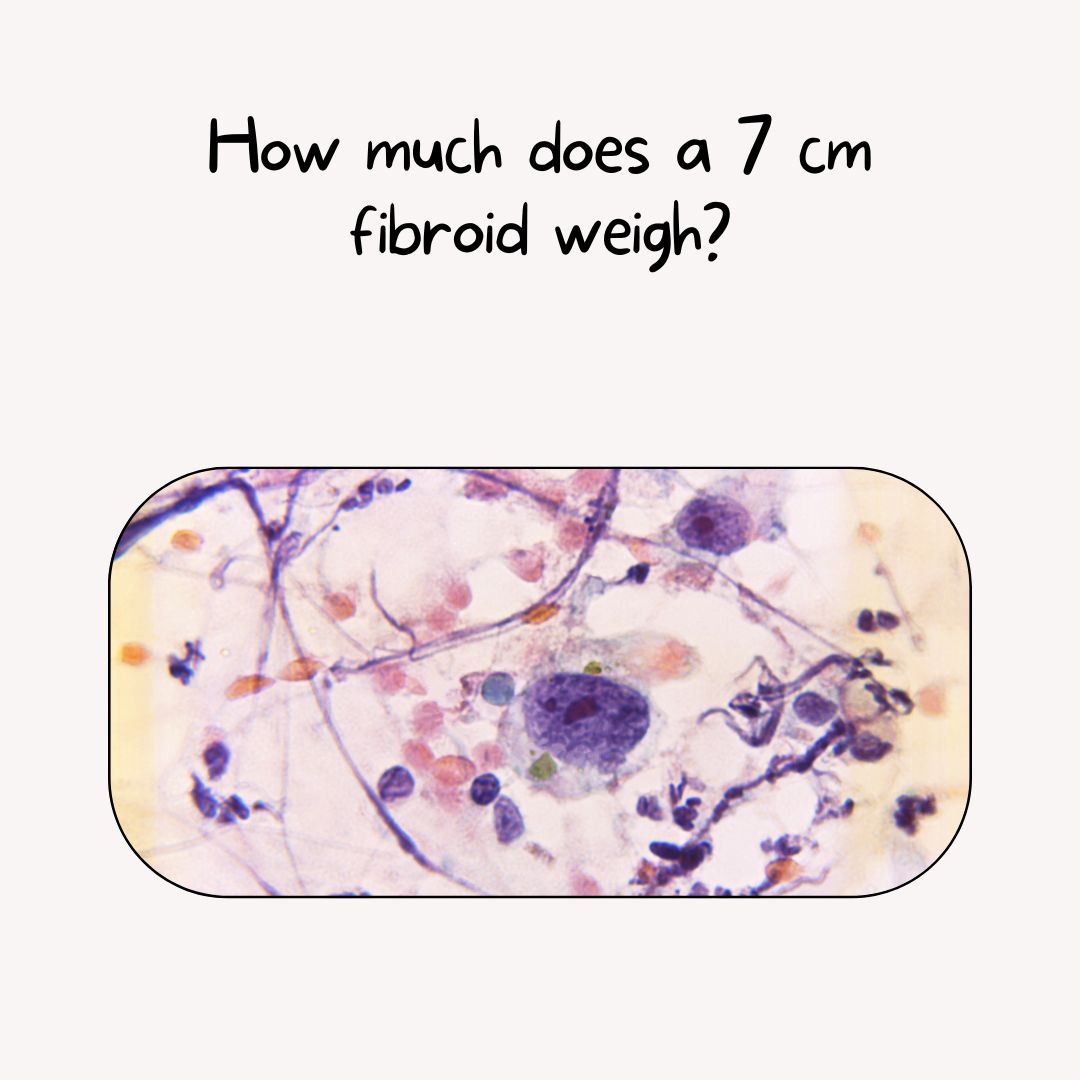How much does a 7 cm fibroid weigh?

How much does a 7 cm fibroid weigh? Fibroids, also known as uterine leiomyomas, are non-cancerous growths that develop in the uterus. These tumors originate from the smooth muscle cells of the uterine wall and can vary significantly in size, shape, and weight. Understanding the weight of fibroids is crucial as it provides valuable insights into their impact on a woman’s health and the treatment options available.
Fibroids exhibit diverse characteristics and can be classified into different types based on their location within the uterus. Submucosal fibroids grow within the uterine cavity, intramural fibroids develop within the muscular wall, and subserosal fibroids extend outward from the uterine surface. Additionally, pedunculated fibroids are attached to the uterus by a stalk-like structure.
The prevalence of fibroids among women is noteworthy. Research suggests that up to 70% of women may develop fibroids by the age of 50. Although the exact cause of fibroid formation remains unknown, factors such as genetic predisposition, hormonal imbalances, and estrogen levels are believed to play a role in their development.
Factors Influencing Fibroid Weight
The weight of a fibroid is influenced by several factors, including its size, location, composition, density, and vascularization. Larger fibroids tend to weigh more than smaller ones due to their increased volume. The location of the fibroid within the uterus can also impact its weight, as submucosal fibroids may be more substantial than intramural or subserosal ones.
Furthermore, the composition and density of fibroids contribute to their weight. Fibroids can consist of various components, including muscle tissue, connective tissue, and blood vessels. Fibroids with a higher density, such as those rich in muscle fibers, may weigh more than fibroids with lower density.
Vascularization and the blood supply to fibroids also affect their weight. Fibroids that receive a robust blood supply may exhibit increased vascularity, resulting in a higher weight due to the presence of blood vessels and associated tissues.
How much does a 7 cm fibroid weigh?
Accurately determining the weight of a fibroid requires diagnostic methods and medical imaging techniques. Healthcare providers may employ methods such as ultrasound, magnetic resonance imaging (MRI), or computed tomography (CT) scans to assess the size and weight of fibroids.
Medical imaging techniques allow healthcare professionals to estimate fibroid weight by measuring their dimensions and volume. Sophisticated algorithms and software can then calculate an approximation of the fibroid’s weight based on these measurements.

Typical Weight Range for 7 cm Fibroids
While the weight of fibroids can vary significantly based on individual characteristics, there is a general weight range associated with different sizes. For 7 cm fibroids, the typical weight can range from approximately 200 grams to 400 grams. It’s important to note that fibroid weight can still deviate within this range due to factors such as composition, density, and vascularity.
Case Studies: 7 cm Fibroid Weigh
Several documented case studies have reported a diverse range of weights for 7 cm fibroids. In one instance, a 7 cm fibroid was found to weigh 250 grams, primarily composed of dense muscle fibers. Another case documented a 7 cm fibroid weighing 350 grams, with a significant blood supply contributing to its weight.
These examples highlight the variability in fibroid weight within the 7 cm size range. The composition and vascularity of each fibroid play a significant role in determining its weight.
Impact of Fibroid Weigh on Symptoms
The size and weight of fibroids can influence the severity of symptoms experienced by women. Generally, larger and heavier fibroids exert greater pressure on surrounding organs, including the bladder and intestines. This pressure can lead to symptoms such as pelvic pain, frequent urination, constipation, and abdominal bloating.
Moreover, heavy fibroids can cause abnormal uterine bleeding, resulting in prolonged or heavy menstrual periods. In some cases, fibroids may even cause anemia due to excessive blood loss. Therefore, understanding the relationship between fibroid weight and symptoms is crucial for effective management and treatment.
Surgical Considerations
Fibroid weight plays a significant role in surgical considerations and procedures. Heavier fibroids may present challenges during surgical interventions, such as myomectomy (fibroid removal) or hysterectomy (removal of the uterus). The weight and size of the fibroid can affect the complexity of the surgery, the duration of the procedure, and the potential for complications.
For instance, larger fibroids may require more extensive incisions, resulting in a higher risk of bleeding, infection, or injury to surrounding tissues. Surgical teams must carefully evaluate the weight and characteristics of fibroids to plan and execute procedures effectively, ensuring the best possible outcomes for patients.
Non-Surgical Treatment Options
While surgical interventions are often necessary for large or symptomatic fibroids, non-invasive treatment options can be considered for managing fibroids of various weights. These options include medication, such as gonadotropin-releasing hormone agonists, which can temporarily shrink fibroids by suppressing hormone production. Additionally, uterine artery embolization (UAE) and magnetic resonance-guided focused ultrasound surgery (MRgFUS) are non-surgical procedures that can target and shrink fibroids.
However, it’s important to note that the weight of fibroids can influence the response to these non-surgical treatments. Larger or heavier fibroids may require more aggressive or prolonged treatment to achieve significant symptom relief or size reduction.
Weight Management Strategies
Lifestyle modifications can play a supportive role in managing fibroid weight. Although weight loss alone may not directly reduce the size of fibroids, it can alleviate symptoms and improve overall well-being. Engaging in regular physical activity, adopting a balanced diet rich in fruits, vegetables, and whole grains, and reducing stress levels can contribute to weight management and potentially help in symptom reduction.
Complications Associated with Heavy Fibroids
Heavy fibroids can pose additional risks and complications compared to smaller ones. The weight of fibroids may increase the likelihood of twisting (torsion) or degeneration, which can lead to acute pain and require emergency medical attention. Furthermore, the presence of large fibroids may impact fertility by interfering with the implantation of a fertilized egg or causing blockages in the fallopian tubes.
During pregnancy, heavy fibroids can increase the risk of complications such as preterm labor, abnormal fetal positioning, or postpartum hemorrhage. Close monitoring and specialized care are essential for women with heavy fibroids who are planning to conceive or are already pregnant.
Fibroid Weigh and Treatment Decisions
When considering treatment options for fibroids, healthcare providers take into account the weight of the fibroids along with other factors such as symptoms, desired fertility, and overall health. Surgical interventions, including myomectomy or hysterectomy, may be recommended for large or heavy fibroids that cause severe symptoms or significantly affect a woman’s quality of life.
Less invasive options, such as medication or non-surgical procedures, are typically considered for smaller fibroids or cases where fertility preservation is a priority. The weight of the fibroids helps guide treatment decisions and allows healthcare providers to customize treatment plans based on individual needs.
Frequently Asked Question
Q: Are there variations in fibroid weights within the 7 cm size range?
A: Yes, there can be variations in fibroid weights within the 7 cm size range due to factors such as composition, density, and vascularity.
Q: How does fibroid weight impact symptoms?
A: Fibroid weight can influence symptom severity by exerting pressure on nearby organs and causing symptoms such as pelvic pain, frequent urination, and abdominal bloating.
Q: What surgical considerations are associated with fibroid weight?
A: Heavier fibroids can pose challenges during surgical procedures, such as myomectomy or hysterectomy, and may increase the risk of complications.
Q: What non-surgical treatment options are available for fibroids?
A: Non-surgical treatment options for fibroids include medication, uterine artery embolization (UAE), and magnetic resonance-guided focused ultrasound surgery (MRgFUS).
Q: How does weight management impact fibroids?
A: While weight loss may not directly reduce fibroid size, it can help alleviate symptoms and improve overall well-being.
Q: What complications can be associated with heavy fibroids?
A: Heavy fibroids can increase the risk of complications such as torsion, and degeneration, and impact fertility and pregnancy outcomes.
Q: How does fibroid weight influence treatment decisions?
A: Fibroid weight is one of the factors considered when choosing treatment options, along with symptoms, fertility goals, and overall health.
Q: What questions should I ask my healthcare provider regarding fibroid weight?
A: It is important to inquire about how fibroid weight affects symptoms, treatment options, and potential risks or complications.
Q: How can fibroid weight be monitored?
A: Regular monitoring through follow-up appointments and imaging examinations helps track changes in fibroid size, weight, and symptoms.
Q: Is emotional support important in managing fibroid weight?
A: Yes, emotional and psychological support can be valuable in coping with the challenges of fibroids, including those related to weight management.
Q: What are some future developments in fibroid treatment?
A: Ongoing research is exploring new treatment options, such as minimally invasive procedures and targeted drug therapies, to improve fibroid management.
Q: What are fibroids and why is fibroid weight important?
A: Fibroids are non-cancerous growths in the uterus, and understanding their weight helps determine treatment options and assess their impact on a woman’s health.
Q: What factors influence fibroid weight?
A: Fibroid weight is influenced by size, location, composition, density, and vascularization.
Q: How is fibroid weight assessed and what is the weight range for 7 cm fibroids?
A: Fibroid weight is assessed through diagnostic methods and medical imaging. 7 cm fibroids typically weigh between 200 grams to 400 grams.
Q: How does fibroid weight affect symptoms and treatment decisions?
A: Fibroid weight can impact symptom severity and influence treatment decisions, including surgical considerations and non-surgical options.
Q: What complications are associated with heavy fibroids?
A: Heavy fibroids can increase the risk of complications such as torsion, and degeneration, and affect fertility and pregnancy outcomes.
Q: How can fibroid weight be monitored and managed?
A: Regular monitoring through follow-up appointments and lifestyle modifications can help manage fibroid weight and improve overall well-being.
Q: What resources are available for further reading on fibroids?
A: Find reputable books, articles, and websites from organizations like ACOG and The Fibroid Foundation for more information on fibroids.
Conclusion:
In conclusion, understanding the weight of fibroids is crucial in comprehending their impact on a woman’s health and determining appropriate treatment strategies. Factors such as size, location, composition, density, and vascularization influence fibroid weight. Accurate assessment of fibroid weight can be achieved through diagnostic methods and medical imaging techniques.
For 7 cm fibroids, the typical weight range falls between 200 grams to 400 grams, although variations can occur based on factors such as composition and vascularity. Fibroid weight plays a significant role in symptom severity, surgical considerations, and treatment decisions.
Monitoring fibroid weight through regular follow-up appointments and imaging examinations is important to track changes over time. Emotional and psychological support, as well as lifestyle modifications, can aid in managing fibroid weight and improving overall well-being.
While surgical options exist for the management of fibroids, non-surgical treatments, such as medication, uterine artery embolization (UAE), and magnetic resonance-guided focused ultrasound surgery (MRgFUS), are also viable alternatives. Additionally, weight loss and lifestyle modifications can help alleviate symptoms associated with fibroids.
Heavier fibroids may pose challenges during surgical procedures and increase the risk of complications. They can also impact fertility and pregnancy outcomes. Therefore, considering fibroid weight is essential when making treatment decisions, alongside other factors such as symptoms, fertility goals, and overall health.
When discussing fibroid weight with healthcare providers, it is crucial to ask relevant questions regarding symptoms, treatment options, and potential risks or complications. Regular monitoring, emotional support, and seeking reputable resources can contribute to a better understanding and management of fibroids.
As medical research progresses, advancements in fibroid treatment continue to emerge. Staying informed about the latest developments and engaging in open discussions with healthcare providers can provide valuable insights into new treatment options and strategies for fibroid management.
In conclusion, comprehending the weight of fibroids is vital in navigating their impact on health, making informed treatment decisions, and improving overall well-being.

One Comment